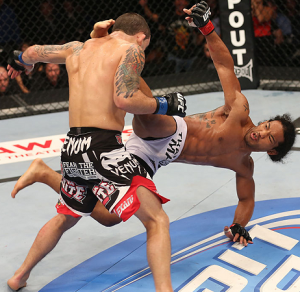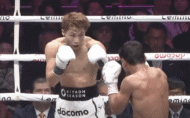Opinion: UFC Pay-Per-View Business On The Decline. Why?
By Tom Taylor
UFC 150 didn’t just mark the second time Frankie Edgar and Benson Henderson fought. It also marked the second time this year that a UFC Pay-Per-View event had fewer than 200,000 buys.
UFC 150 garnered a mere 190,000 Pay-Per-View buys, and in July, UFC 147 was bought by only 140,000 viewers. These numbers are record lows for the UFC, plain and simple.
For contrast, consider that 2011’s absolute weakest Pay-Per-View buy-rate was roughly 225,000. That’s 85,000 more than 2012’s worst Pay-Per-View thus far.
Looking even further back, 2010’s least successful Pay-Per-View scraped together 240,000 buys. That’s 100,000 more than 2012’s worst, and the year is far from over. Clearly, something is going wrong.
Sure, UFC 145, 146, and 148 have done well, raking in roughly 700,000, 700,000 and 900,000 buys apiece. Certainly, the UFC can still put together a successful Pay-Per-View.
Still, the organization has not seen numbers as low as UFC 147 and UFC 149’s since the sport starting gaining traction following The Ultimate Fighter’s first season. This seems to be a glaring contradiction: what happened to the popularity and entrance into the mainstream that was supposed to coincide with the UFC’s deal with FOX? What’s happening here?
The most obvious explanation seems to be an oversaturation of UFC shows. For example, in 2010, the UFC had held 12 shows by this time in August. In 2011, the frequency of events increased slightly, as the UFC had held 15 shows by this time. This year the UFC has hosted 21 events— nearly double the number it had hosted by midway through August 2010.
True, many of these cards were free, especially given the UFC’s new presence on FOX, and its subsidiaries, FX and Fuel TV, but the fact is that suddenly MMA fans have more opportunities to watch the UFC. For example, the MMA fan who is struggling to pay his rent, things have suddenly become more straightforward.
Previously, free UFC shows were held only sporadically, occurring every so often on Spike TV. Now, spaced over three networks, the UFC is available for free on TV fairly frequently.
So, in opting to forgo buying cards like UFC 147 and 150, which undeniably lacked real celebrity and name value, fans would not be deprived of the UFC for long. They still got to watch famous light heavyweights knock each other silly for free on FOX the week before UFC 150.
Suddenly the choice not to buy UFC 150 is much less painful. And with UFC 151 just two weeks later (anchored by rising superstar Jon Jones and MMA legend Dan Henderson), the choice to brush aside UFC 150 and watch the highlights the next day comes even easier.
With UFC Pay-Per-Views packed so tightly together, and free cards sprinkled in between as garnish, it’s not surprising fans are opting out of weaker looking Pay-Per-Views. The high-density of UFC events also leads to another problem, however. Suddenly, the UFC needs to provide exponentially more matchups, given the increased number of events.
Events used to be much more spaced out, and the result was cards that were stacked thick with promising matchups. Now, in the wake of such an increase in the number of UFC shows, the result is cards like UFC 147.
Without taking anything away from Wanderlei Silva and Rich Franklin, who are both true legends of MMA, their rematch at UFC 147 wasn’t exactly one fans were clamouring for. And while the match it replaced (another rematch, between Silva and Vitor Belfort), was a little more sought after, even it wasn’t the kind of matchup that sells a UFC Pay-Per-View with the same success as UFC 145, 146, or 148.
All this leads us to an additional pitfall of such frequent cards. Given that each card now boasts much fewer big-name matchups, an injury that prevents one of those integral matchups from happening can be a killer for Pay-Per-View’s success.
Take UFC 147. First, it appeared our main event would be between Anderson Silva and Chael Sonnen, (a fight that was later bumped to UFC 148, a card that was in dire need of saving itself, as it too had been pillaged by injury). This left UFC 147 with Wanderlei Silva vs. Vitor Belfort as a main event.
Cue a Belfort injury…and Franklin steps up to fight Silva, leaving us with a rematch that really doesn’t advance the status of the winner all that much. Sure, an entertaining fight, but a relevant one? No. And in today’s economy, no fan wants to shell out fifty-odd bucks for irrelevance. Instead, they’ll save their money for the rare card that isn’t plagued by injury, in an MMA landscape that is often thick with cards that are ravaged shells of their former selves.
While the idea of a UFC card to watch every weekend would have any true MMA fan salivating, it just doesn’t seem to be a sustainable business model. Maybe there’s something here that we’re missing, as the UFC continues to pack the calendar with shows, but it would not be surprising to see low Pay-Per-View buy rates (like those of UFC 147 and 150), continue.
Long gone are the days, it seems, of a card so stacked that fans anticipate it for months. Sure, the UFC’s fifth appearance on Fox, which is now being filled with fights, looks great—but UFC 147 once did too.
Now look ahead to UFC 152, a Pay-Per-View that was recently robbed of a hyped-up matchup between prospect Rory MacDonald and former two-division champ, BJ Penn. Without this fight, it’s hard to be optimistic about the card’s success. Anchored only by a title fight in the UFC’s newest, (and thus least followed) division, the card will be difficult for flyweights Joseph Benavidez and Demetrius Johnson to carry.
Even with an appealing middleweight matchup between Brian Stann and Michael Bisping supporting them—from the early outlook, anyway—UFC 152 does not have Pay-Per-View success written all over it.
With the UFC’s talent spread so thin over so many cards, many of which are free, it is hard to imagine rising UFC Pay-Per-View buy-rates— a stern indicator of decreased demand among fans. Fewer, albeit beefier events, then, could be the best thing for UFC and its fans alike; the UFC would probably see its Pay-Per-View buys spike back up, and we, the fans, would be provided with cards packed to the brim with blockbuster matchups and the beautiful violence we all love.










